Bayeux tapestry:a ten-century-old object of desire
In July 2018, in the context of Brexit, Emmanuel Macron officially announced the loan of the famous Bayeux Tapestry to Great Britain, the loan being granted from 2020. In reality, this cultural project hides important economic contracts between the two countries, then in disagreement on many subjects, and therefore rather than being the object of a nice gratuitous gesture, the Bayeux Tapestry serves above all as a diplomatic asset for negotiations. But then, why is this tapestry so desired by the English? Moreover, how could it have been in history, and is still today, an object of desire, when in practice it is a simple embroidery?
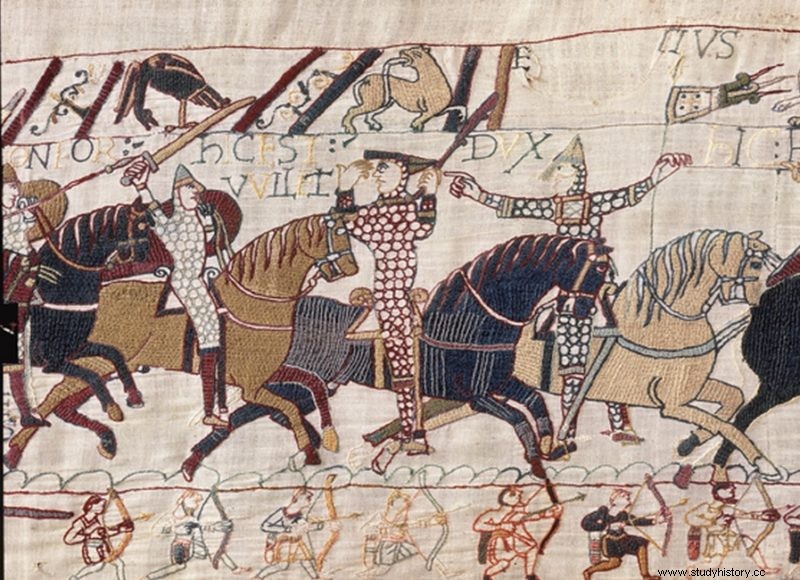
The epic tale of a major political event:the conquest of England
What does this famous tapestry say? Nothing less than the famous Battle of Hastings in 1066! This massive confrontation between two colossal armies, the Anglo-Saxon army and the Norman army led by William Duke of Normandy, marked a major turning point in history, with the victory of the Normans and its consequence:the reign of William the Conqueror.
Let's take a closer look at the Tapestry to understand the story it gives of this event through 58 scenes. First scene:Edward the Confessor on his throne, flanked by two of his advisers, including his brother-in-law Harold Godwinson . We are in 1064:the old King Edward, feeling near death and having no heir, charges Harold, the greatest of English aristocrats, to propose to William of Normandy , little cousin of Edward, his succession to the throne of England, as he had promised. Indeed, Edouard is very attached to Normandy since he found refuge there for thirty years, driven out of England because of the Danish invasion. Harold leaves with his messengers to reach the Normandy coast, but the following scene shows him, as soon as he arrives in France, taken prisoner by a powerful local lord. Fortunately, Guillaume is in charge of negotiating his deliverance, and this is why we see on the tapestry Harold swearing allegiance to Duke Guillaume. He takes an oath on two reliquaries, well represented to emphasize the inviolability of this promise. Woe to perjurers!
Let's quickly focus on the figure of Guillaume, the main protagonist of this story. Who is he ? He was born in 1027 from an illegitimate union between the Duke of Normandy Robert the Magnificent and the daughter of a tanner, and this illegitimate birth earned him the name of William the Bastard, before becoming William the Conqueror. He succeeded his father at the age of 8, but he already imposed his power and succeeded in making Normandy a powerful kingdom. In 1050 he married one of his cousins, Mathilde de Flandres. It is he who is designated as the future king of England by Edward, but this accession to the English throne will not be without difficulty...
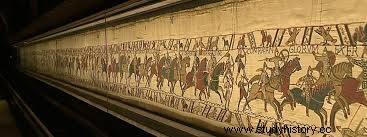
A new scene from the tapestry projects us two years later, in 1066. King Edward dies, his funeral is held, but the next moment Harold is crowned King of England. The oath is violated! Guillaume, furious, decides to win back what is due to him. He embarked on a rather crazy conquest for the time, since on the one hand it was a question of conquering a kingdom four times larger than the Duchy of Normandy, and on the other hand the crossing of the Channel was not done not without difficulty, especially when it comes to taking 15,000 men and 5,000 horses with you! All these boats parade on the tapestry to dock on the English coast, in the south of the country. There, the troops of Guillaume await firmly those of Harold by building fortifications. On October 14, 1066, near Hastings, a formidable battlefield was formed, where soldiers, whether English or Norman, fought a fierce battle of unprecedented violence. Take a good look, they are even identifiable on the embroideries:the Anglo-Saxons are represented with a mustache and long hair, on foot, with an ax in hand, while the Normans, on horseback, have their necks shaved and slay their opponents with their spears. The latter shout “Dex ouch! », at the same time an invocation to God, a call for help, and a cry of encouragement. But finally, Harold is killed by an arrow in the eye:perjury is punished! The English troops carry out a disastrous retreat in panic, and... it is victory for the Normans!
The scene of the fleeing English closes the story of the tapestry. However, it lacks the last meters, lost during the adventures that the work has undergone. We can imagine that the story was originally completed by the coronation of William, on December 25, 1066, thus taking the official name of “William the Conqueror”. Following the Battle of Hastings, William will found an extremely powerful Anglo-Norman kingdom, and it is since this conquest that the language of the Anglo-Saxon elite is Norman, hence the English royal motto again today in French "God is my right".
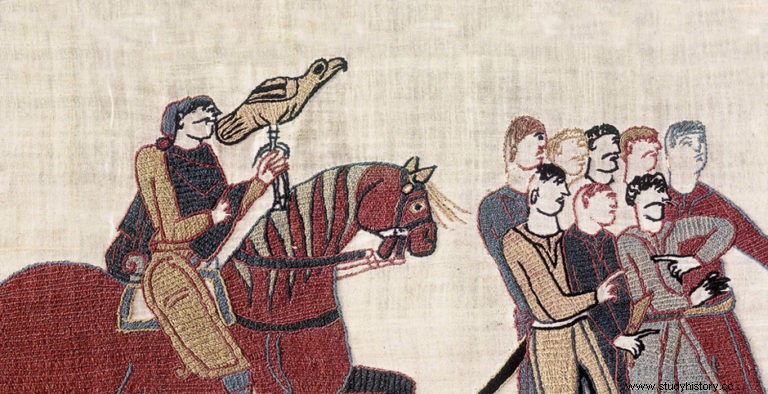
A work of propaganda
This narrative embroidery is 68m long and consists of nine bound linen canvas panels. It is a monumental work aimed precisely at recounting a single event:the Battle of Hastings. Why such a company?
In reality, historians still have doubts about the origins of the commissioning of this tapestry. The most likely hypothesis is that the sponsor was Odon , bishop of Bayeux and half-brother of Guillaume, with the aim of adorning the Cathedral of Bayeux in 1077. Indeed, this hypothesis is reinforced by the fact that Odon is a very represented character in the tapestry while his role in the historical event is only secondary. The aim of this tapestry would then not only be to tell a story, but it would above all be a work of propaganda aimed at making William's conquest legitimate by its exhibition in a religious place, the Cathedral. This perspective is certainly less romantic than the legend developed in the 19th century through the name “Tapestry of Queen Mathilde” , wanting it to be Queen Mathilde and her servants who embroidered the tapestry, like Penelope waiting for Ulysses to return.
A historical and artistic document
626 characters, 202 horses, 37 buildings, all embroidered with ten threads of wool… This tapestry is a magnificent masterpiece of 11th century Romanesque art. century. In fact, the term "tapestry" is incorrect, since it is actually an embroidery if we observe the technique used:in fact, the use of four different embroidery stitches gives this realization a amazing relief, and gives it its unique character. But hey, even if it's an embroidery, the monumentality of this work running on 70 m of walls deserves its name of tapestry!
Beyond being a beautiful artistic object, the Bayeux Tapestry is also a precious historical document, in that it offers tremendous testimony to medieval times. It provides us with architectural information, for example on the way in which the military fortifications of the time, called “motte castrale”, were built. You can even see Mont-Saint-Michel! It also represents an interesting ethnographic source on the life of the armies, the carrying of weapons (spear for the Normans, ax for the English), the various equipment such as the hauberk, etc... The ships resemble Viking longships, with dragons in figureheads. Not surprising, if we remember that the Norman people came from the Viking invasions on the French coasts from the 9th th century!
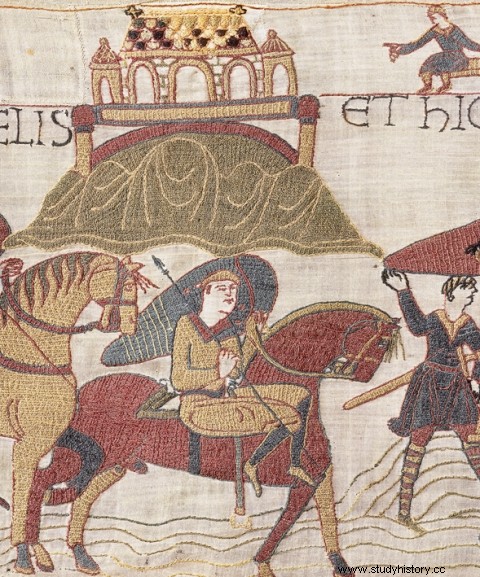
However, this historical document is not so clear, and still remains an enigma today... What do these figures mean on the friezes surrounding the central band? There are real or imaginary animals there… Oh look, a crow and a fox! And there the wolf and the lamb! What a visionary work, six centuries before La Fontaine! In fact, these fables were written in antiquity by the poet Aesop, before inspiring our famous French poet. But then why did the author of the tapestry illustrate them on the sidelines of the central battle scene? No one will know...
An object of political manipulation
If the tapestry has come down to us, it is indeed the result of a miracle! It had a very turbulent history... It first remained seven centuries in its place of origin, at Bayeux Cathedral, where it was hung once a year in the nave and kept for the rest of the year. in a wooden box. It was seized during the Revolution by the Arts Commission to ensure its protection since, according to legend, it was almost cut up to cover the soldiers' carts, but fortunately a sensible man prevented the disaster. It was instrumentalized in 1803 by Napoleon to adorn his new museum:would this be a legitimation to go and conquer England? Then it went to Bayeux in 1812 where it is exhibited at the Town Hall every year in September, unfolding with the help of a crank...
It was at the heart of the Second World War that the Bayeux Tapestry would be particularly coveted. It was brought to safety in an underground shelter in 1938, but very quickly, the political significance of this work interested the Nazis, who entrusted its study to specialized German teams. It was transferred to different places before ending up in the Louvre, where it was the subject of an exhibition in November 1944. Is it a question of celebrating a new French victory through the memory of the Norman victory? Once again, the tapestry served a political purpose... It was finally sent back in March 1945 to Bayeux, where it can still be seen today on display in the Old Grand Seminary.
To further show the topicality of this tapestry, one can read on the British military memorial in Bayeux:“We, vanquished by William, have liberated the homeland of the victor”…
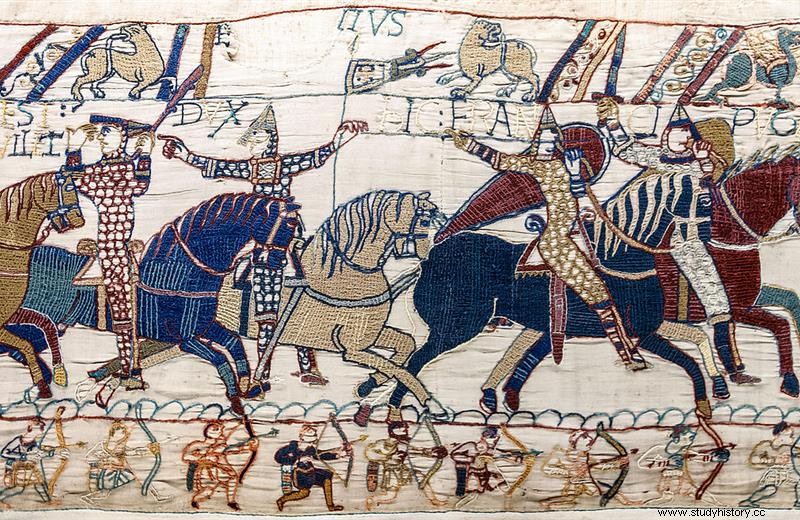
Thus, this beautiful artistic object that can be admired in Bayeux conceals a fascinating history, object of political manipulation, of ideological diversion... Today, it is a question of lending this work, support of national pride for the French, to England, in a now pacified context between the two countries. The loan is not expected to occur before 2022 or 2023, when the museum will be closed for the construction of a new museum. However, this is a loan only, not a return, because, whatever the English say, the Bayeux Tapestry is indeed French!
